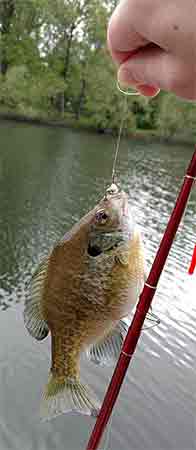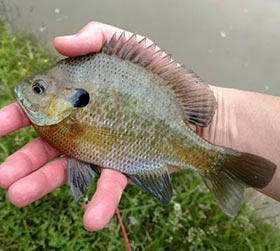 Tip 1: Start simple
Tip 1: Start simple
A cane pole is a good way for new anglers (and especially young kids) to start fishing – no overhead casting required. Spincast gear is a rod and closed face reel with a push button for easy casting and reeling. The next step is ultra-light spinning gear – these open-face reels are a little harder to use but casting distance and accuracy improves.
Tip 2: Lighten your line
Monofilament ("single strand of plastic") line in a box, spool, or reel, labeled 4LB or 6LB will do the job. "LB" stands for "pound test" and it’s the amount of force it takes to break the line. Light line has more flexibility and sensitivity than heavier line. Unless you’re targeting monster catfish or muskies, light line is your best bet.
Tip 3: Bag the big bobbers
Bobbers (or floats) are used to provide a little extra weight for casting, suspend your bait in the water at a certain depth, and to alert you when to "set the hook" (which is reeling in the line slack and pulling up on the rod above your shoulder). The harder the bobber is to pull under, the harder it will be to hook a fish. Small, thin "pencil-style" floats will help convince the fish to take your tasty bait and bite the hook. "Slip" bobbers also work well. Slip bobber rigs cut down on the amount of line needed at the end of the rod and may make it easier to cast. Small ice fishing bobbers can provide a light touch any time of year.
Tip 4: Sink it with shot
Sinkers (or weights) help with casting your line out and getting your bait down to the fish. A properly selected weight can create "neutral buoyancy." Ideally, you want your bobber to just barely float upright on the top of the water. Your bobber will sink if there’s too much weight. Squeeze small BB-sized split shot sinkers onto your line, one at a time, until your bobber nearly sinks from the weight. Since there is very little resistance when the fish takes the bait, it is more likely to bite the hook and run.
Tip 5: Small hooks = big catches
Use hook sizes 6 to 10 (size 6 is larger than size 10). Fish won’t readily take large hooks unless they are feeding like crazy. A subtle presentation is often needed to catch wary fish. Tiny hooks also allow smaller fish to "inhale" the bait, rather than nibble the bait off the hook. If a fish swallows the hook and you want to return the fish to the water, simply cut the line as close to the hook as possible and release the fish. For a safer hook, smash down the barb with pliers or use barbless hooks.
Tip 6: Great big gobs of worms won’t do
There’s no need to use a large night crawler on your hook. Smaller live bait such as red worms, wax worms (bee moth larvae) or crickets work best. Keep the bait approximately the size of your hook, so the fish is less likely to steal your bait. You can also cut the bait to fit your hook. When you’re finished with the bait, give it to another angler, bring it home for the next trip, or throw it in the trash. Never dump your bait into the water – releasing bait could introduce an aquatic invasive species.
Tip 7: Fish Local
The best place to go fishing when you’re just starting to learn is a place close to home. Regardless of whether it’s an urban fishing park or a retention pond in your neighborhood, find a spot to fish that doesn’t require a lot of travel time. You can find public fishing sites across the state with our Where to Fish map.


 Tip 1: Start simple
Tip 1: Start simple